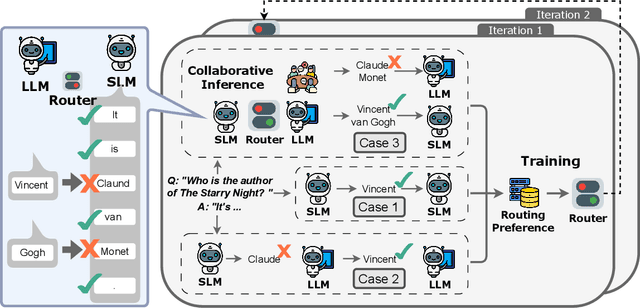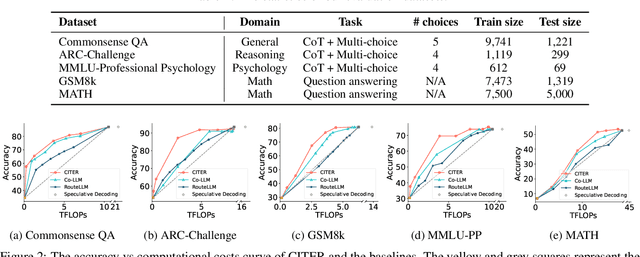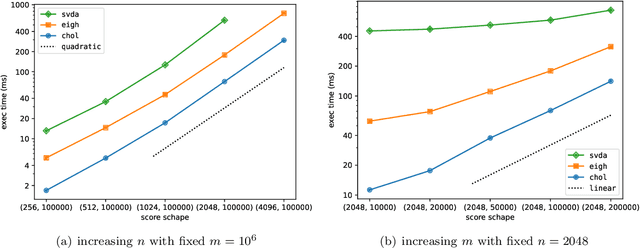Yixiao Chen
AInsteinBench: Benchmarking Coding Agents on Scientific Repositories
Dec 24, 2025Abstract:We introduce AInsteinBench, a large-scale benchmark for evaluating whether large language model (LLM) agents can operate as scientific computing development agents within real research software ecosystems. Unlike existing scientific reasoning benchmarks which focus on conceptual knowledge, or software engineering benchmarks that emphasize generic feature implementation and issue resolving, AInsteinBench evaluates models in end-to-end scientific development settings grounded in production-grade scientific repositories. The benchmark consists of tasks derived from maintainer-authored pull requests across six widely used scientific codebases, spanning quantum chemistry, quantum computing, molecular dynamics, numerical relativity, fluid dynamics, and cheminformatics. All benchmark tasks are carefully curated through multi-stage filtering and expert review to ensure scientific challenge, adequate test coverage, and well-calibrated difficulty. By leveraging evaluation in executable environments, scientifically meaningful failure modes, and test-driven verification, AInsteinBench measures a model's ability to move beyond surface-level code generation toward the core competencies required for computational scientific research.
Context-Aware Autoregressive Models for Multi-Conditional Image Generation
May 18, 2025Abstract:Autoregressive transformers have recently shown impressive image generation quality and efficiency on par with state-of-the-art diffusion models. Unlike diffusion architectures, autoregressive models can naturally incorporate arbitrary modalities into a single, unified token sequence--offering a concise solution for multi-conditional image generation tasks. In this work, we propose $\textbf{ContextAR}$, a flexible and effective framework for multi-conditional image generation. ContextAR embeds diverse conditions (e.g., canny edges, depth maps, poses) directly into the token sequence, preserving modality-specific semantics. To maintain spatial alignment while enhancing discrimination among different condition types, we introduce hybrid positional encodings that fuse Rotary Position Embedding with Learnable Positional Embedding. We design Conditional Context-aware Attention to reduces computational complexity while preserving effective intra-condition perception. Without any fine-tuning, ContextAR supports arbitrary combinations of conditions during inference time. Experimental results demonstrate the powerful controllability and versatility of our approach, and show that the competitive perpormance than diffusion-based multi-conditional control approaches the existing autoregressive baseline across diverse multi-condition driven scenarios. Project page: $\href{https://context-ar.github.io/}{https://context-ar.github.io/.}$
Performance Analysis of Deep Learning Models for Femur Segmentation in MRI Scan
Apr 05, 2025Abstract:Convolutional neural networks like U-Net excel in medical image segmentation, while attention mechanisms and KAN enhance feature extraction. Meta's SAM 2 uses Vision Transformers for prompt-based segmentation without fine-tuning. However, biases in these models impact generalization with limited data. In this study, we systematically evaluate and compare the performance of three CNN-based models, i.e., U-Net, Attention U-Net, and U-KAN, and one transformer-based model, i.e., SAM 2 for segmenting femur bone structures in MRI scan. The dataset comprises 11,164 MRI scans with detailed annotations of femoral regions. Performance is assessed using the Dice Similarity Coefficient, which ranges from 0.932 to 0.954. Attention U-Net achieves the highest overall scores, while U-KAN demonstrated superior performance in anatomical regions with a smaller region of interest, leveraging its enhanced learning capacity to improve segmentation accuracy.
STGA: Selective-Training Gaussian Head Avatars
Mar 07, 2025Abstract:We propose selective-training Gaussian head avatars (STGA) to enhance the details of dynamic head Gaussian. The dynamic head Gaussian model is trained based on the FLAME parameterized model. Each Gaussian splat is embedded within the FLAME mesh to achieve mesh-based animation of the Gaussian model. Before training, our selection strategy calculates the 3D Gaussian splat to be optimized in each frame. The parameters of these 3D Gaussian splats are optimized in the training of each frame, while those of the other splats are frozen. This means that the splats participating in the optimization process differ in each frame, to improve the realism of fine details. Compared with network-based methods, our method achieves better results with shorter training time. Compared with mesh-based methods, our method produces more realistic details within the same training time. Additionally, the ablation experiment confirms that our method effectively enhances the quality of details.
RIFLEx: A Free Lunch for Length Extrapolation in Video Diffusion Transformers
Feb 21, 2025Abstract:Recent advancements in video generation have enabled models to synthesize high-quality, minute-long videos. However, generating even longer videos with temporal coherence remains a major challenge, and existing length extrapolation methods lead to temporal repetition or motion deceleration. In this work, we systematically analyze the role of frequency components in positional embeddings and identify an intrinsic frequency that primarily governs extrapolation behavior. Based on this insight, we propose RIFLEx, a minimal yet effective approach that reduces the intrinsic frequency to suppress repetition while preserving motion consistency, without requiring any additional modifications. RIFLEx offers a true free lunch--achieving high-quality $2\times$ extrapolation on state-of-the-art video diffusion transformers in a completely training-free manner. Moreover, it enhances quality and enables $3\times$ extrapolation by minimal fine-tuning without long videos. Project page and codes: \href{https://riflex-video.github.io/}{https://riflex-video.github.io/.}
Dual-Flow: Transferable Multi-Target, Instance-Agnostic Attacks via In-the-wild Cascading Flow Optimization
Feb 05, 2025



Abstract:Adversarial attacks are widely used to evaluate model robustness, and in black-box scenarios, the transferability of these attacks becomes crucial. Existing generator-based attacks have excellent generalization and transferability due to their instance-agnostic nature. However, when training generators for multi-target tasks, the success rate of transfer attacks is relatively low due to the limitations of the model's capacity. To address these challenges, we propose a novel Dual-Flow framework for multi-target instance-agnostic adversarial attacks, utilizing Cascading Distribution Shift Training to develop an adversarial velocity function. Extensive experiments demonstrate that Dual-Flow significantly improves transferability over previous multi-target generative attacks. For example, it increases the success rate from Inception-v3 to ResNet-152 by 34.58%. Furthermore, our attack method shows substantially stronger robustness against defense mechanisms, such as adversarially trained models.
CITER: Collaborative Inference for Efficient Large Language Model Decoding with Token-Level Routing
Feb 04, 2025



Abstract:Large language models have achieved remarkable success in various tasks but suffer from high computational costs during inference, limiting their deployment in resource-constrained applications. To address this issue, we propose a novel CITER (\textbf{C}ollaborative \textbf{I}nference with \textbf{T}oken-l\textbf{E}vel \textbf{R}outing) framework that enables efficient collaboration between small and large language models (SLMs & LLMs) through a token-level routing strategy. Specifically, CITER routes non-critical tokens to an SLM for efficiency and routes critical tokens to an LLM for generalization quality. We formulate router training as a policy optimization, where the router receives rewards based on both the quality of predictions and the inference costs of generation. This allows the router to learn to predict token-level routing scores and make routing decisions based on both the current token and the future impact of its decisions. To further accelerate the reward evaluation process, we introduce a shortcut which significantly reduces the costs of the reward estimation and improving the practicality of our approach. Extensive experiments on five benchmark datasets demonstrate that CITER reduces the inference costs while preserving high-quality generation, offering a promising solution for real-time and resource-constrained applications.
Unsupervised Search for Ethnic Minorities' Medical Segmentation Training Set
Jan 05, 2025



Abstract:This article investigates the critical issue of dataset bias in medical imaging, with a particular emphasis on racial disparities caused by uneven population distribution in dataset collection. Our analysis reveals that medical segmentation datasets are significantly biased, primarily influenced by the demographic composition of their collection sites. For instance, Scanning Laser Ophthalmoscopy (SLO) fundus datasets collected in the United States predominantly feature images of White individuals, with minority racial groups underrepresented. This imbalance can result in biased model performance and inequitable clinical outcomes, particularly for minority populations. To address this challenge, we propose a novel training set search strategy aimed at reducing these biases by focusing on underrepresented racial groups. Our approach utilizes existing datasets and employs a simple greedy algorithm to identify source images that closely match the target domain distribution. By selecting training data that aligns more closely with the characteristics of minority populations, our strategy improves the accuracy of medical segmentation models on specific minorities, i.e., Black. Our experimental results demonstrate the effectiveness of this approach in mitigating bias. We also discuss the broader societal implications, highlighting how addressing these disparities can contribute to more equitable healthcare outcomes.
Ground state phases of the two-dimension electron gas with a unified variational approach
May 29, 2024



Abstract:The two-dimensional electron gas (2DEG) is a fundamental model, which is drawing increasing interest because of recent advances in experimental and theoretical studies of 2D materials. Current understanding of the ground state of the 2DEG relies on quantum Monte Carlo calculations, based on variational comparisons of different ansatze for different phases. We use a single variational ansatz, a general backflow-type wave function using a message-passing neural quantum state architecture, for a unified description across the entire density range. The variational optimization consistently leads to lower ground-state energies than previous best results. Transition into a Wigner crystal (WC) phase occurs automatically at rs = 37 +/- 1, a density lower than currently believed. Between the liquid and WC phases, the same ansatz and variational search strongly suggest the existence of intermediate states in a broad range of densities, with enhanced short-range nematic spin correlations.
Efficient Numerical Algorithm for Large-Scale Damped Natural Gradient Descent
Oct 26, 2023

Abstract:We propose a new algorithm for efficiently solving the damped Fisher matrix in large-scale scenarios where the number of parameters significantly exceeds the number of available samples. This problem is fundamental for natural gradient descent and stochastic reconfiguration. Our algorithm is based on Cholesky decomposition and is generally applicable. Benchmark results show that the algorithm is significantly faster than existing methods.
 Add to Chrome
Add to Chrome Add to Firefox
Add to Firefox Add to Edge
Add to Edge